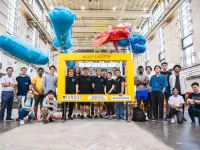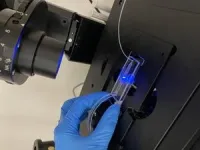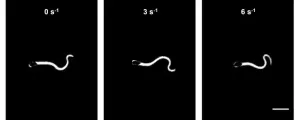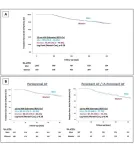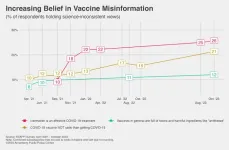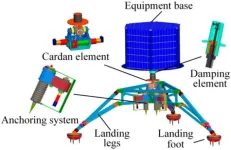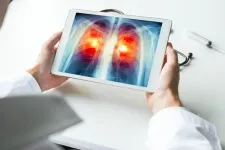(Press-News.org) In nature, swarms can accomplish amazing things. Schools of fish can more efficiently find food and migrate. Flocks of birds can confuse predators. Bees, ants, and termites can work together to feed, defend and build their colonies.
Robotics researchers have long been trying to harness this ability to explore environments, capture objects and build structures using robot swarms.
“But the problem of how do we efficiently control all those robots is still unsolved,” says David Saldaña, an assistant professor of computer science and engineering in Lehigh’s P.C. Rossin College of Engineering and Applied Science.
Saldaña, who leads the SwarmsLab and is a member of the Autonomous and Intelligent Robotics (AIR) Lab at Lehigh, recently received a three-year, $755,000 grant from the Office of Naval Research to design aerial swarms and develop control methods that rely on physical inter-robot interaction.
Typically, he says, robot swarms are manipulated by controlling each robot individually. And to be successful, swarms must operate in well-defined spaces and environmental conditions—with negligible or constant wind, for example—and be tested repeatedly in that space.
“If I send the robots to a different environment where there might be obstacles, moving objects, and wind, it’s a different story,” says Saldaña. “We’re still very limited with what we can do.”
Saldaña and his team hypothesize that if the robots are physically connected—like ants that use their bodies to form a bridge for others in the colony to traverse—they may be easier to control and more robust to challenging conditions. The researchers will test three types of physical connectors: rigid bars, flat sheets and ropes. They will use each to perform a variety of tasks and measure how effective the connected robots are in grabbing and transporting objects.
What makes the team’s approach particularly novel, he says, is that they are developing new control algorithms while creating these robots from scratch.
“In our lab, we don’t buy robots, we make robots,” he says. “And since the robots we’re using don’t exist anywhere else, we have to push the boundary in control theory. As we’ve advanced the design, we’ve discovered some very interesting control problems that haven’t been explored in the literature. We’re constantly going back and forth between hardware and software, and that’s what makes this project so interesting.”
The team has already developed prototypes using each approach and will test them in November at the annual Defend the Republic Drone Competition. This year’s event is being held Nov. 17 on Lehigh’s Mountaintop Campus (in High Bay C2). It will feature eight university teams competing in a Quidditch-esque game (see: Harry Potter) in which autonomous robots vie to capture floating helium balloons and deliver them to the opponent’s goal: Lehigh University, George Mason University, University of Florida, Baylor University, West Virginia University, Indiana University, Virginia Tech and Drexel University The purpose of the competition is to drive research and innovation in vehicle design, multi-agent control, swarm behaviors, and communication.
“Lehigh has been to this competition twice, and this year, as hosts, we plan to have at least 30 robots entered,” he says. “It gives us the opportunity to evaluate them in a real setting doing repetitive work. And what’s cool about this event is that everyone is trying to achieve the same goal using different research approaches, and they’re all willing to share their solutions to different problems. We’ve learned a lot from our colleagues.”
Ultimately, the work Saldaña and his team are doing could be applied to tasks like drone delivery by providing more information on the types of connections necessary between robots to move packages of varying sizes. It could also help in search and rescue efforts when the swarm size necessary for the task isn’t clear. “If you don’t know how bad the situation is, you might not know if you need large or small robots, so if you can take many smaller robots and simply attach them depending on the situation on-site, that could solve the problem.”
Harnessing a robotic swarm and successfully manipulating its components to do essential tasks will be exceedingly difficult. But for Saldaña the challenge is not only endlessly interesting but also a great way to entice the next generation of computer scientists interested in both theory and practice.
“When I talk to students, I tell them, we do robot hardware, we do mathematics, we do physics, we do control theory, modeling, and rigorous experimentation. We’re constantly switching between software and hardware because that’s where robotics is—right in the middle.”
Research reported in this story is supported by the United States Navy/Office of Naval Research/Department of Defense, under award number N000142312535.
Related Links
Video: Using Robots to Help People
Lehigh University: SwarmsLab
Lehigh University: Autonomous and Intelligent Robotics (AIR) Lab
Rossin College Faculty Profile: David Saldaña
Defend the Republich Drone Competition at Lehigh University END
Do physical connections improve the control and performance of robot swarms?
A Lehigh University research team explores the question by building novel control algorithms and linked robots. Prototypes will be put to the test in the Defend the Republic Drone Competition Nov. 17.
2023-11-01
ELSE PRESS RELEASES FROM THIS DATE:
Dr. Jennifer Lotz appointed Space Telescope Science Institute Director
2023-11-01
The Association of Universities for Research in Astronomy (AURA) is pleased to announce the appointment of Dr. Jennifer Lotz as the Director of the Space Telescope Science Institute (STScI). Dr. Lotz will begin her five-year appointment as STScI Director starting February 12, 2024. Previously, Dr. Lotz was the Director of the International Gemini Observatory which is operated by NSF’s NOIRLab, and managed by AURA.
“Dr. Lotz is a science driven, accomplished leader,” said Dr. Matt Mountain, President of AURA, which manages STScI on behalf of NASA. “Jen’s passion for the Institute’s mission, to enable the ...
Sperm adjust their swimming style to adapt to fluctuating fluid conditions
2023-11-01
Sperm can modulate their energetics by regulating their flagellar waveform—how the sperm oscillate their tails—in order to adapt to varying fluid environments, potentially optimizing their motility and navigation within the reproductive tract. This research is reported in a study publishing November 1 in the journal Cell Reports Physical Science.
“Our approach allowed us to investigate how variations in viscosity and shear rates affect sperm behavior at the single-cell level, which was not possible using traditional methods,” says senior study author Reza Nosrati of Monash University.
Biochemical and biophysical cues within the reproductive ...
Women with atrial fibrillation significantly benefit from pulsed field ablation procedures
2023-11-01
Women with atrial fibrillation (AF) undergoing a procedure called pulsed field ablation (PFA) have just as good outcomes as men with AF undergoing the same procedure, according to a large-scale international study led by the Icahn School of Medicine at Mount Sinai.
This study is the first to compare sex outcomes for AF patients undergoing PFA, which is a new technology and the latest ablation modality that can be used to restore a regular heartbeat. The results also show PFA is safe and just as effective for men as for women. Findings were published October 5 in JAMA Cardiology.
“These results are important, as ...
Prevalence, awareness, and treatment of elevated LDL cholesterol in adults, 1999-2020
2023-11-01
About The Study: Although the prevalence of severely elevated low-density lipoprotein cholesterol (LDL-C) has declined, 1 in 17 U.S. adults still have LDL-C levels of 160 to 189 mg/dL and 1 in 48 adults have LDL-C levels of 190 mg/dL or greater. Among those with an LDL-C of 190 mg/dL or greater, 1 in 4 are unaware and untreated, with a higher proportion for an LDL-C of 160 to 189 mg/dL. These gaps disproportionately affect non-Hispanic Black, Hispanic, and socioeconomically disadvantaged persons, contributing to disparities in outcomes.
Authors: Salim S. Virani, M.D., Ph.D., of Aga Khan University in Karachi, Pakistan, ...
Adverse life experiences and brain function
2023-11-01
About The Study: In this meta-analysis of 83 neuroimaging studies of adversity exposure and brain function, prior adversity exposure was associated with altered adult brain reactivity to diverse challenges. These results might better identify how adversity diminishes the ability to cope with later stressors and produces enduring susceptibility to mental health problems.
Authors: Niki Hosseini-Kamkar, Ph.D., of the Royal Ottawa Hospital in Ottawa, Ontario, Canada, is the corresponding author.
To access the embargoed ...
Vaccine confidence falls as belief in health misinformation grows
2023-11-01
PHILADELPHIA – Americans have less confidence in vaccines to address a variety of illnesses than they did just a year or two ago, and more people accept misinformation about vaccines and Covid-19, according to the latest health survey from the Annenberg Public Policy Center (APPC) of the University of Pennsylvania.
The survey conducted October 5-12, 2023, with a panel of over 1,500 U.S. adults, finds that the number of Americans who think vaccines approved for use in the United States are safe dropped to 71% from 77% in April 2021. The percentage of adults who don’t think vaccines approved in the U.S. are safe grew to 16% from ...
How the relationship between the land and atmosphere facilitated the persistence of eastern China’s extreme weather and climate in summer 2022?
2023-11-01
Extreme weather and climate events, such as droughts, heatwaves, and rainstorms, pose serious threats to human health, agricultural production, and energy supplies. These events often occur at the same time, and such "compound extreme events" can cause far more damage than any one single event. Climate scientists from the research group of Prof. Aihui Wang from the Institute of Atmospheric Physics, Chinese Academy of Sciences, Beijing, China, argue in a new study that land–atmosphere coupling (the coupling ...
Immune checkpoint inhibition, when administered together with single fraction stereotactic radiosurgery, does not appear to increase risk of radiation necrosis in patients with brain metastases
2023-11-01
MIAMI, FL – November 1, 2023 -- Miami Cancer Institute, part of Baptist Health South Florida, announced the publication of a multi-institutional retrospective cohort study about the impact of immune checkpoint inhibition (ICI) and single-fraction stereotactic radiosurgery (SRS) on radiation necrosis (RN) in patients with brain metastasis from non-small cell lung cancer. The study, titled “Immune Checkpoint Inhibition and Single Fraction Stereotactic Radiosurgery in Brain Metastases from Non-Small Cell Lung Cancer: An International Multicenter Study of 395 Patients” ...
Scientists developed a legged small celestial body landing mechanism for landing simulation and experimental test
2023-11-01
Landing stably is the precondition for exploring the small celestial body in situ. The surface of small body is weak gravity and irregular, and the surface environment is unknown and uncertain. The landing mechanism tends to rebound and turn over, and the landing stability time is long. However, there is difference on the Moon and the Mars surface while most of the landing performance researches are focused on the lunar landing so far. Therefore, it is of great important to study the landing ...
American Cancer Society updates lung cancer screening guideline: Nearly five million US adults who smoke and formerly smoked now recommended for testing
2023-11-01
ATLANTA, November 1, 2023 — Today, the American Cancer Society (ACS) released an update of its lung cancer screening guideline to help reduce the number of people dying from the disease due to smoking history. The new guideline recommends yearly screening for lung cancer for people aged 50 to 80 years old who smoke or formerly smoked and have a 20-year or greater pack-year history. The recommended annual screening test for lung cancer is a low-dose computed tomography scan (also called a low-dose CT scan, or LDCT). The guideline, last updated ...
LAST 30 PRESS RELEASES:
Longest observation of an active solar region
Why nail-biting, procrastination and other self-sabotaging behaviors are rooted in survival instincts
Regional variations in mechanical properties of porcine leptomeninges
Artificial empathy in therapy and healthcare: advancements in interpersonal interaction technologies
Why some brains switch gears more efficiently than others
UVA’s Jundong Li wins ICDM’S 2025 Tao Li Award for data mining, machine learning
UVA’s low-power, high-performance computer power player Mircea Stan earns National Academy of Inventors fellowship
Not playing by the rules: USU researcher explores filamentous algae dynamics in rivers
Do our body clocks influence our risk of dementia?
Anthropologists offer new evidence of bipedalism in long-debated fossil discovery
Safer receipt paper from wood
Dosage-sensitive genes suggest no whole-genome duplications in ancestral angiosperm
First ancient human herpesvirus genomes document their deep history with humans
Why Some Bacteria Survive Antibiotics and How to Stop Them - New study reveals that bacteria can survive antibiotic treatment through two fundamentally different “shutdown modes”
UCLA study links scar healing to dangerous placenta condition
CHANGE-seq-BE finds off-target changes in the genome from base editors
The Journal of Nuclear Medicine Ahead-of-Print Tip Sheet: January 2, 2026
Delayed or absent first dose of measles, mumps, and rubella vaccination
Trends in US preterm birth rates by household income and race and ethnicity
Study identifies potential biomarker linked to progression and brain inflammation in multiple sclerosis
Many mothers in Norway do not show up for postnatal check-ups
Researchers want to find out why quick clay is so unstable
Superradiant spins show teamwork at the quantum scale
Cleveland Clinic Research links tumor bacteria to immunotherapy resistance in head and neck cancer
First Editorial of 2026: Resisting AI slop
Joint ground- and space-based observations reveal Saturn-mass rogue planet
Inheritable genetic variant offers protection against blood cancer risk and progression
Pigs settled Pacific islands alongside early human voyagers
A Coral reef’s daily pulse reshapes microbes in surrounding waters
EAST Tokamak experiments exceed plasma density limit, offering new approach to fusion ignition
[Press-News.org] Do physical connections improve the control and performance of robot swarms?A Lehigh University research team explores the question by building novel control algorithms and linked robots. Prototypes will be put to the test in the Defend the Republic Drone Competition Nov. 17.
